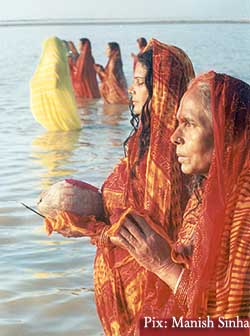|
(Bihar Times):
At last Chhath, the greatest festival of Bihar, got national recognistion. On
Friday the Indian Parliament changed its earlier schedule and rested as the date
clashed with Chhath, a festival in which till recently people of Bihar and to
some extent East Uttar Pradesh, used to worship Sun God. The origin of Chhath
can be traced centuries back in the Ganga region of Bihar.  But
now this festival is being observed everywhere outside Bihar and even India. As
Biharis live in a large number outside their own state they took this tradition
with them. Biharis living abroad would seek Ganga jal (water) from their relatives
and friends in the state to observe the annual ritual of Chhath, which starts
on the sixth day after Diwali. But
now this festival is being observed everywhere outside Bihar and even India. As
Biharis live in a large number outside their own state they took this tradition
with them. Biharis living abroad would seek Ganga jal (water) from their relatives
and friends in the state to observe the annual ritual of Chhath, which starts
on the sixth day after Diwali.
But
Biharis have been living outside the state, even country, for over 100-125 years,
especially in the West Indian islands and Mauritius and Fiji. But their number
increased recently. Two
factors can be attributed to the recognition of Chhath internationally and nationally.
One is the advent of television channels and second and even equally important
is the Lalu phenomenon. The observance of Chhath by his wife Rabri Devi and he
himself played a key role in the export of this festival of serenity. Unlike other
Hindu festivals there is hardly any pomp and show and there is no idol worship
during Chhath; though of late we find some idols installed on the roads of Patna. However,
even Lalu-Rabri’s observance of Chhath would not have got national recognition
without the television channels. Not only Chhath the television contributed to
the growth of festivals like Teej as well. Television channels also played a key
role in highlighting the inimitable style of Lalu Yadav playing Holi. Now other
politicians like Yashwant Sinha too play Holi in his own style and gets publicity. When
this correspondent wrote a feature on Chhath in the Sunday Review pull out of
the Times of India 13 years back many readers outside the state were not aware
of this festival of fasting among Hindus. But now the worshipping of Sun-God is
not confined to the bank of river Ganga, but to almost all the rivers of the country,
sea beaches and other water bodies. Another Bihari, Sanjay Nirupam, earlier in
Shiv Sena and now with Congress, too contributed to the growth of the state’s
identity in Mumbai by organizing this festival in a big way. The
rituals of Chhath involve paying homage by pouring milk before the setting Sun
one day and to the rising Sun the next morning. It is now increasingly done by
the side of water bodies, not necessarily Ganga alone. The other special feature
about Chhath, is that the 36 hours fast on this occasion is being observed more
by women than men. *(The
author is a free-lance journalist.)
Comment |